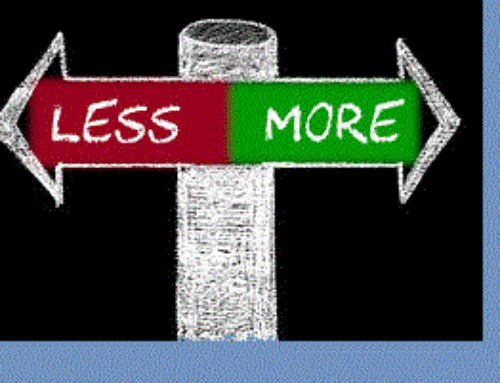Economist Robert Barone has outlined here the essence of current challenge for policy makers and the Federal Reserve at this pivotal time. Have a look at this commentary, it’ll be worth your time! Robert is a Georgetown educated economist. He is a financial advisor at Fieldstone Financial, www.FieldstoneFinancial.com. We’re proud to share his exceptional analysis here.
Market volatility looks to have become the norm of late, with intraday swings of 500 points on the Dow Jones Industrials seemingly commonplace. The days of complacency and ever rising stock prices appear to be firmly in the rear-view mirror, now replaced by daily angst. And, with good reason. Markets have fully recognized that “synchronized” world economic growth has ended, that the U.S. economy is not an island, immune from international issues, and that internal growth is decelerating. New worries are that the deceleration could easily morph into recession, especially if the Fed makes a policy mistake, as they have historically been wont to do. The following are issues of concern:
- China’s growth is the weakest it has been since the Great Recession;
- All Fed GDP models put Q4/18 below 3% (Atlanta: 2.8%, New York: 2.6%, St. Louis: 2.9%), a clear recognition of growth deceleration;
- Growth outside the U.S. has slowed significantly: Europe’s GDP growth appears to be at or below 1%; with Italy now showing negative growth; even Germany’s usually robust export numbers have stagnated;
- Housing in the U.S. has clearly rolled over;
- Capex, which had a spurt in Q1 and Q2, was flat in Q3 and it doesn’t look like that was temporary;
- There is growing concern about the health, or at least the willingness, of the U.S. consumer to continue to spend beyond their incomes and continue to drawdown their savings; perhaps the Q4 downdraft in the equity markets has had an impact on consumer confidence;
- The Fed’s latest minutes appear to show some concern about risk and leverage in the corporate world. Corporate debt looks bloated; rising interest rates are bound to have a negative impact, especially with significant debt coming due over the next 4 years. The fixed income markets are now eschewing higher risk companies; spreads to Treasuries have widened considerably since August, and this trend has accelerated of late;
- Given the $100.5 billion federal budget deficit for this month (November), what kind of responsible fiscal policy response could there be if a recession actually presents itself?
- And more…
Corporate Debt Overhang
Over the next four years, more than $3.5 trillion of corporate debt must be refinanced, over $500 billion in 2019, and then about $1 trillion in each of the next three years. This debt is going to be competing for the available liquidity. The Federal leviathan appears to have an insatiable appetite for spending beyond its means. In addition to supply from high deficits, supply will be increased with the additional release of Treasuries and mortgage-backed securities from the Fed’s balance sheet (currently $50 billion/month, but scheduled to increase). All of this will have to be refinanced at higher interest rates.
In the corporate debt world, there was already a glut of BBB paper. In ’09, 32% of corporate issues were rated BBB. That rose to 50% as borrowing at 1% or 2% seemed like a good idea, and Wall Street was offering such paper “covenant lite,” meaning that normal requirements, like minimum financial ratios, weren’t required. Then came the early October downgrade of once mighty GE to Baa1/BBB+ (stable by both), only three notches above junk status. Since then, bond buyers have moved toward higher quality, and have required higher yields on corporate paper.
Given the magnitude of upcoming corporate financing needs, rising interest costs, and rising wage and material costs as cost-push inflation emerges, corporate cash is going to be diverted from capex spending and from stock buybacks. It should be noted that capex, which was up significantly in Q1 and Q2 and showed a year over year growth rate of 8.8% as late as July, has rapidly fallen, showing only a 1.9% year over year growth in September with negative readings in both the August and September monthly data releases. Corporate excess cash, then, won’t be as available for buybacks as it has been in the recent past, and this is bound to have a negative impact on the level of the equity indexes. CFOs will be closely managing their cash, paying down their leverage (and paying up for their employees and raw materials), lest the rating agencies downgrade them to junk status. Look at what has happened to GE’s stock price since their ratings downgrades (and their bonds now trade like junk despite investment grade ratings).
Housing
Housing has always been a reliable leading indicator. In this cycle, due to Dodd-Frank regulations, housing was constrained by a lack of supply, as local developers, hamstrung by credit issues from the bursting of the housing bubble, were unable to garner enough bank credit to increase the supply. Thus, this housing cycle was marred by rapidly rising home prices. But, make no mistake, today’s issues have more to do with demand than supply. For the first time in a long time, the median home price is falling! And, with rising interest rates, home affordability is also falling. Mortgage applications fall each week, and every housing indicator is significantly negative. We have seen rising sales at Home Depot and Lowe’s, as homeowners have now decided to fix up what they have rather than move up. But, it ends there. In this fix-up cycle, consumer intentions to purchase new furniture and appliances are simply non-existent.
Other Consumer Issues
To make things worse, delinquencies on auto and student loans are at post-recession highs, and, suddenly, restaurant sales, always a reliable sign of consumer well being, are down noticeably. Perhaps the fall in stock prices since the beginning of Q4 has had a negative impact on consumer confidence. This may even show up in the November confidence surveys (released in early December).
While falling gasoline prices should ease some of the angst, wouldn’t it be wise to ask why oil prices have fallen so far and so fast? Only a few weeks ago, analysts were pondering and discussing the possibility of oil prices at or above $100/bbl. My, how fast things have changed! Could this be the result of rapidly waning demand?
The Banks
Things can’t be all that good when bank loan growth is barely positive. In the latest Fed survey, the net share of banks reporting stronger commercial loan demand fell to a seven-year low, even while they were easing their loan standards. That same Fed survey showed weaker demand for commercial and residential real estate loans, and flat demand for consumer loans (including credit card balances). The fastest growing area of bank balance sheets is their holdings of U.S. Treasury securities, perhaps partly explaining why the Treasury yield curve has not risen as fast as the Fed has pushed up the Federal Funds rate.
Cost-Push Inflation
In the regional Fed surveys, both prices paid and prices received by private sector companies have been rising, with prices paid (raw materials) rising faster than prices received. This has negative consequences for profit margins (and therefore equity prices). The surveys further show significant upward wage pressures. All in, cost-push inflation appears to have returned after nearly a 40-year hiatus. What’s the Fed to do – caught between the Scylla and Charybdis of waning growth and rising inflation?
Conclusion
I haven’t talked about China’s woes, about the slowdown in the EU, or about the issues now facing emerging markets. The U.S. is not an island, and issues in the rest of the world are certain to impact the U.S. economy. But, just looking at the domestic economy, it is clear that deceleration is accelerating! And this is what is driving the volatility in the financial markets. Investors may now be concluding that the probability of a 2019 recession is not trivial, as was thought just a few short weeks ago. And, continued tightening by the Fed, whose hands may be tied by the rise in the cost-push inflation indicators, is really making investors nervous.
For even more, be sure to read on over at Forbes.






